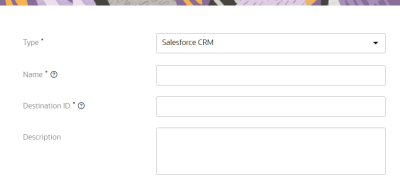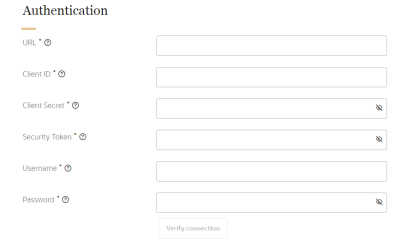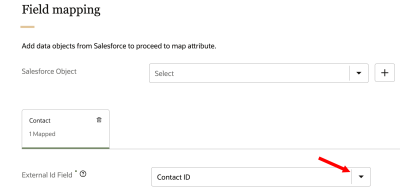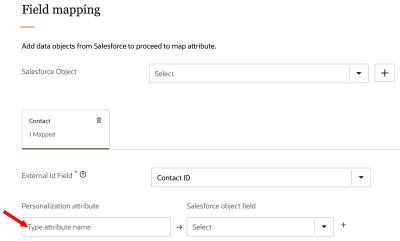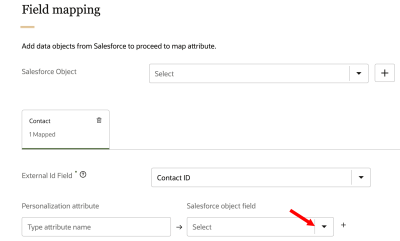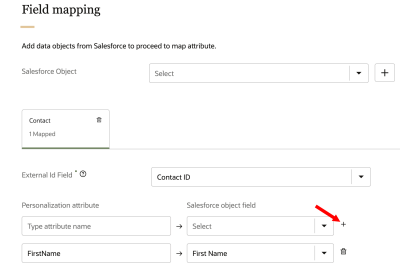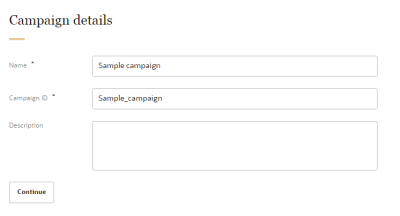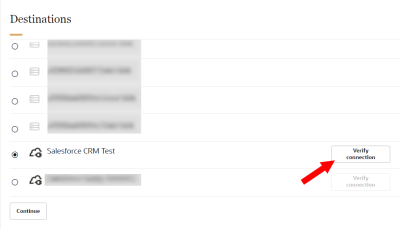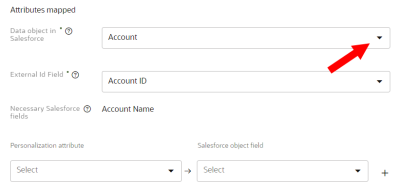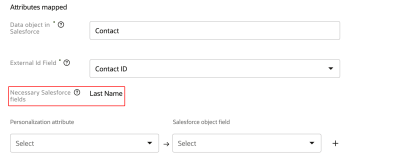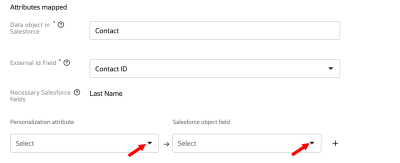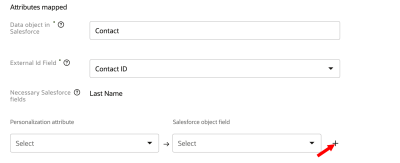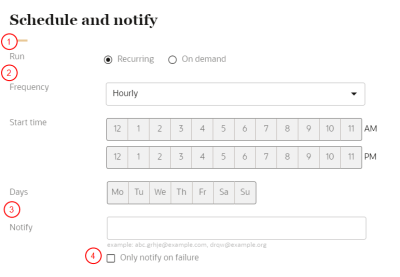Setting up the export of data to Salesforce CRM
To set up and run the export of data to Salesforce CRM, you'll need to do the following:
Create a Salesforce CRM destination
You will need to create the Salesforce CRM destination to configure where the data will be exported to.
To create the Salesforce CRM destination:
-
Click the Oracle icon
 in the bottom-right corner to open the navigation menu.
in the bottom-right corner to open the navigation menu.
- Select Destinations.
- In the top-right corner, click Create destination.
Step 1: Define destination details
The job details section allows you to define the type of destination and how it will display in Oracle Unity.
Enter the information for the destination.
- Type: Use the drop-down list to select Salesforce CRM.
- Name: Enter a name. The name must be 1 or more characters, up to a maximum of 50. Use only letters (a–z and A–Z), numbers (0–9), underscores (_), hyphens (-), and spaces. The first character cannot be a space.
-
Destination ID: The unique system identifier that is auto-populated from the destination name you enter. You can't change this value after you create the destination.
- Description: Enter a description. This field is optional, but it is highly recommended to add descriptions for any entity created. This helps all other users get additional context when using and navigating Oracle Unity. The description can have a maximum of 512 characters with no restrictions on characters used. You can use characters from all languages supported in the language settings.
Step 2: Configure authentication settings
Enter the information to allow Oracle Unityto access the required data from Salesforce.
- URL: Enter the base URL of your Salesforce account.
- Client ID: Enter the Client ID of your Salesforce account.
- Client Secret: Enter the client secret of your Salesforce account.
- Security Token: Enter the security token of your Salesforce account.
- Username: Enter the username of your Salesforce account.
- Password: Enter the password of your Salesforce account.
Once you enter all the details, click Verify connection to ensure that Oracle Unity can access the server. If there are connection issues, confirm the server path and authentication settings entered are correct.
Field mapping section
This section allow you to configure field mapping between Oracle Unity personalization attributes and Salesforce object fields.
-
You also have the option of configuring field mapping while creating the segment delivery that uses this destination.
-
You can leave this section without field mapping and configure all field mapping while creating the segment delivery.
-
Any configurations/updates you make to field mapping in the segment delivery will override any configurations made in the destination settings.
To configure the field mapping:
-
Use the drop-down list for Salesforce Object to select the object that has the Salesforce object fields you want to map.
-
Click Add
 .
. -
Select an External Id Field. This is a unique identifier for the object in Salesforce and is used for UPSERT operations. If the parameter exists, use the insert command. If the parameter doesn't exist, use the update command.
-
Under Personalization attribute, enter the exact name of the Unity personalization attribute you want to map.
-
Under Salesforce object field, select the object field you want to map to the Unity personalization attribute.
-
Click Add
 .
. -
Continue creating mappings for the selected Salesforce object.
-
If needed, configure additional Salesforce objects and corresponding mappings.
Step 3: Save and publish the new destination
When finished defining the destination, scroll to the top of the page and click Save or Save and close.
Once you create the destination, you will need to publish the changes.
Create the Salesforce CRM segment delivery
After creating and publishing the destination, you can create the segment delivery and select the segment to export.
To create the segment delivery:
-
Click the Oracle icon
 in the bottom-right corner to open the navigation menu.
in the bottom-right corner to open the navigation menu.
- Select Segment Deliveries.
- In the top-right corner, click Create segment delivery.
The Create segment delivery page is displayed.
Step 1: Define segment delivery details
The segment delivery details section allows you to define how the segment delivery will display in Oracle Unity. You will also need to select the segment to export.
To define the segment delivery details:
- Enter the details for the segment delivery.
-
Name: Enter a name. The name must be 1 or more characters, up to a maximum of 30. Use only letters (a–z and A–Z), numbers (0–9), underscores (_), hyphens (-), and spaces. The first character cannot be a space.
-
Campaign ID: The unique system identifier for your campaign. You can't change this value after you create the campaign.
- If the campaign name uses English characters, the Campaign ID field is auto-populated from the campaign name you enter. You can change this value before the campaign is created.
- If the campaign name uses characters from another language supported in the language settings, the Campaign ID field will be left blank. You will need to enter a name using English characters.
-
Description: Enter a description. This field is optional, but it is highly recommended to add descriptions for any entity created. This helps all other users get additional context when using and navigating Oracle Unity. The description can have a maximum of 512 characters with no restrictions on characters used. You can use characters from all languages supported in the language settings.
- Click Continue.
Step 2: Select destination
You will select the Salesforce CRM destination you created earlier.
To select a destination:
- Select the Salesforce CRM destination.
- Click Verify connection to ensure that Oracle Unity can access the destination.
- After verifying the connection, click Continue.
Step 3: Select segment
You will select the segment and then map Oracle Unity personalization attributes and Salesforce attributes. You can only map one Salesforce data object for the segment delivery.
Any mappings you configure in this section will override the mappings configured in the selected destination settings.
To select a segment:
- Open the drop-down list for segments or search by segment name to select the segment.
- In the Attributes mapped section, select the data object in Salesforce you want to use for field mapping.
- Select the External Id Field. This is a unique identifier for the object in Salesforce and is used for UPSERT operations. If the parameter exists, use the insert command. If the parameter doesn't exist, use the update command.
- Review the Necessary Salesforce fields that must be mapped.
- Under Personalization attribute, select the Unity attribute you want to map. Under Salesforce object field, select the field you want to map to the Unity attribute.
- Click Add
 .
. - When done configuring the field mapping, click Continue.
Step 4: Schedule and notify
You will need to configure the schedule and notification settings for the segment delivery.
To schedule the segment delivery and define the notification settings:
- Configure the schedule for the segment delivery:
- Click Recurring to automatically run the segment delivery job on a regular schedule.
- Click On demand to run the segment delivery job as needed.
- If the segment delivery job is recurring, select the Frequency, Start time, and Days it will run.
- In the field for Notify, enter the email addresses of people to be notified when the segment delivery job runs. Separate multiple emails with a comma.
- If you only want a notification if the segment delivery job fails, click the checkbox Only notify on failure.
Step 5: Save and publish the segment delivery
After saving the segment delivery you will need to publish the changes before it can run.
To save and publish the segment delivery:
- Scroll to the top of the page and click Save or Save and close.
- Follow the steps for Publishing changes.
Run the segment delivery job
After the publish job successfully completes, you can run the segment delivery job, either as a scheduled job or manually from the Data feeds page. You can then monitor its progress from the Jobs dashboard.
Once the segment delivery job successfully completes, you can view the exported data in the Salesforce CRM application.
